BY LETTER
Bubblehabs
History > 0030 to 0900 AT: Solsys Era > 400 to 530 AT: The Solsys Golden Age
History > 0030 to 0900 AT: Solsys Era > 530 to 900 AT: The Sundering
Technology > Application > Transportation > Atmospheric Transport
Technology > Application > Construction
Technology > Application > Infrastructure
Technology > Application > Megascale Engineering
Technology > Technology Levels > Middle Tech / Midtech
History > 0030 to 0900 AT: Solsys Era > 530 to 900 AT: The Sundering
Technology > Application > Transportation > Atmospheric Transport
Technology > Application > Construction
Technology > Application > Infrastructure
Technology > Application > Megascale Engineering
Technology > Technology Levels > Middle Tech / Midtech
Artificial habitats that float in a planetary atmosphere | |
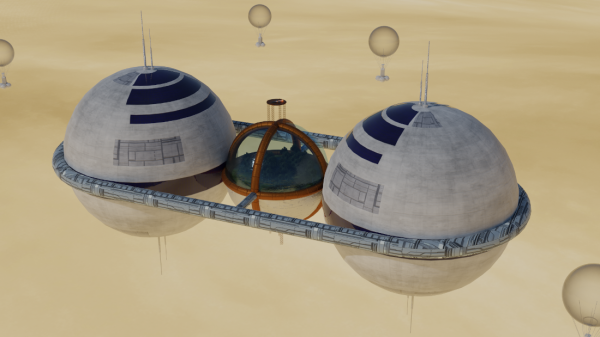 Image from Copyright Lilly Harper | |
| A double bubblehab in the atmosphere of Flank, a cytherian type world | |
Snapshot: Stormy Weather
Aldan nervously watched the vicious, swirling gases of Saturn from inside the comfort and safety of his personal bubblehab. Seeing the clouds of ammonia violently impacting the hab's transparent walls reminded him far too much of the typhoon he got caught in during his childhood on Venus. Even though the structure's systems reported the impact to be well within safety tolerance, and his early years were over a century removed, Aldan decided that it would be best for him to go back inside.
He darted through the knee-deep starflowers in his garden, quickly tracing a path back towards his home in the center of the habitat - a small cottage fabricated in the neomedieval style. The bubblehab had informed him that the storm would pass within thirty minutes, but for Aldan that was thirty minutes much too long.
Closing the door behind him, Aldan breathed a heavy sigh of relief, looking around at the inside of the cottage that was both quaint and fully polymorphic. Responding to his mood, the windows darkened, and a comfortable armchair formed by the hearth.
Lightning flashed and thunder boomed; Tarry, Aldan's pet rug, scampered towards his owner. Realizing that Tarry was even more scared of the storm than himself, Aldan began gently rubbing one of its corners. "It's okay, it's okay," he whispered, through his implants ordering treats from the nearby mealfab. The tassels on Tarry's corners began to wiggle as he started to smell the intriguing aroma pervading Aldan's home.
And as they both ate their meals the raging storm went on and on, forgotten at least momentarily.
Bubblehabs are artificial habitats that float in an atmosphere, usually the atmosphere of a cool gas giant or ice giant planet. The basic design dates all the way back to the Interplanetary Age, and the simple and robust technologies involved have been further refined in the millennia since.
Bubblehabs are so called because the structure is held aloft by an envelope of lifting gas, the 'bubble'. This is typically pure hydrogen held at a temperature above that of the surrounding air. The size of the envelope varies dramatically, but is most typically a few hundred metres to a few kilometres across at the longest axis. Shapes also vary, but those resembling gigantic balloons or airships are the most common. A bubblehab is constructed almost entirely with elements refined from the planetary atmosphere, and it generates its own power, also from local resources. The vast majority of modern bubblehabs are self-repairing and neumann-capable.
The reproductive capacity of typical bubblehabs means that an initial introduction of even one such hab to a suitable planet can lead to a very large volume of living space within a short period of time. The relative ease and convenience of creating a bubblehab, its reliability, and the self-sufficiency of the habs once they are created are attractive features and account for their vast numbers. In modern times bubblehabs of one sort or another are ubiquitous in the Terragen Sphere; they are found in nearly every inhabited star system that has a gas giant planet, and may support a large fraction of the system's population. In some cases the number of persons in the bubblehabs scattered through the atmosphere of even a single gas giant may run into the trillions.
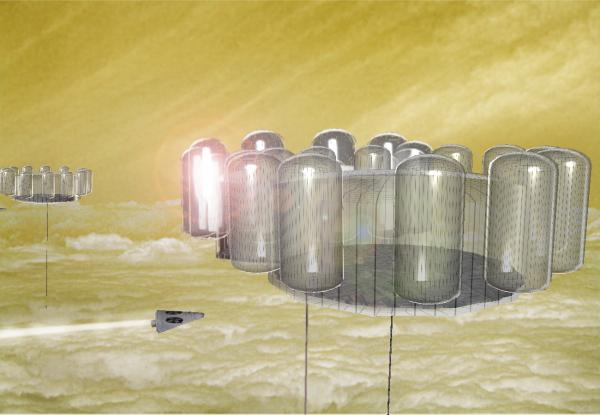 Image from Steve Bowers | |
| Landis bubblehabs at Venus' 50km level (before this world was terraformed) | |
Though the variant found in a cool gas or ice giant's atmosphere is by far the most common, other environments also support habs of similar design. Bubblehabs may be found floating in the atmospheres of the smaller rocky planets. These are the bubblehabs seen in many Cytherean atmospheres that resemble the ancient floating Landis habs of Solsys's Venus, or the small arcologies known for historical reasons as fullairs that were first seen in the atmosphere of Old Earth and now float in the atmosphere of many a Gaian world. The opportunities are greatest though for bubblehabs built in the vastly broader and more abundant skies of gas giants. A cold atmosphere offers the best lift, and the smaller mesojovians that resemble old Uranus or Neptune in size offer not only improved lift but an atmosphere richer in building materials something close to standard Terragen gravity, so they are very popular. However the warmer hydrojovian or even azurijovian planets have also been colonized and superjovians and even the cooler brown dwarf stars have been populated by specialized heavy-grav clades. While originally most bubblehabs floated near the one bar level, some are now designed to rest much deeper in the local atmosphere, where the pressure is at tens or hundreds of bars, though in such cases the hab space must be constructed to resist the ambient pressure or else the inhabitants must be beings who are adapted to it.
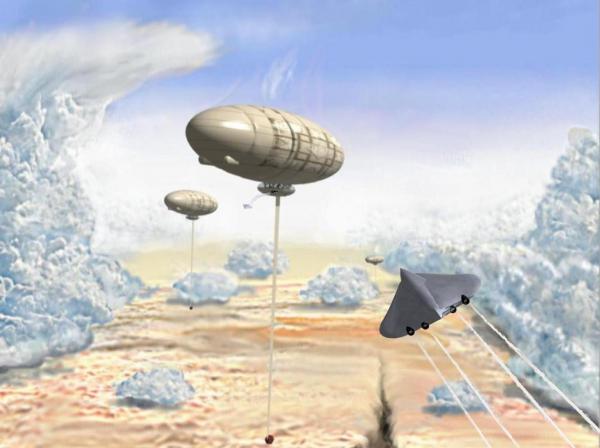 Image from Steve Bowers | |
| Cloud cities on Canaria, using hot hydrogen as a lifting gas | |
Structure
The classical bubblehab, and still by far the most common type, is a balloon-shaped or airship-shaped lifting envelope several kilometres across. The envelope has multiple internal cells containing hydrogen from the atmosphere that has been heated so that together the envelope and its payload habitat are neutrally buoyant. Nestled in the lift envelope is a living area a few kilometres across. Originally this always contained a Terragen-standard environment but in the present day that varies considerably according to a clade's requirements. The oldest bubblehabs, like those still found in low technology regions today, were powered by fusion reactors; even primitive early designs function extraordinarily well in a gas giant atmosphere, because it is easy to sort the rare isotopes of hydrogen and helium that a fusion reactor needs. Most modern habs use the conversion technologies instead that have been standard since the 16th century AT, but older designs are still an option.In standard designs, automatic nanotech systems maintain a bubblehab and scavenge the atmosphere for building and maintenance materials. The hab itself is an artificial organism; it has at least the kind of vegetative awareness of a plant or a plantbot, but even the earlier models could be sentient or sapient, and some are even transapient. The first Interplanetary Age bubblehabs were manufactured by sophonts and their bots, but by the dawn of the Solsys Golden Age designs arose that were neumann-capable, and could grow and reproduce the way most modern bubblehabs do.
There are many variants on the basic bubble hab theme, particularly regarding the size and shape, the degree to which the hab grows, maintains, and reproduces itself autonomously, and the environment in which the hab lives.
Size and Shape
Though blimp-shaped, balloon-shaped and lenticular profiles are common, there are wedge-shaped bubble habs as well as other variants; any shape practical for an aerostat or airship may be used. A bubblehab may be a mere dozen or hundred metres across, supporting a single homestead, or it might be a gigantic structure up to tens of kilometres in diameter. The typical size is just a few kilometres. If the supporting atmosphere is warm and the gases in the lifting envelope therefore need to be relatively hot, the living areas may hang well below the lifting envelope rather than be nestled within it. In some circumstances bubblehabs may link together to form rafts of such structures, but on most planets turbulence in the atmospheres puts constraints on the size and duration of such arrangements.The lift envelope of a bubblehab is insulated from the surrounding atmosphere by a layer of aerogel to help preserve its heat. It typically has many subdivisions, so that the effect of a leak or puncture that has not yet been healed with onboard nano or bionano systems has minimal effect. The relative size of the lift envelope to the payload that is the bubble-hab's living area varies according to the environment. In this it is the temperature and composition of the lifting gas compared to that of the general atmosphere that is the most important; since it is a matter of buoyancy the local gravity is not significant. For instance the volume of hydrogen gas heated to the temperature of a standard Terragen environment required to lift a metric ton of mass at the one bar level in one of the gas giants at Solsys is as follows:
Jupiter: 14000 m3
Saturn: 9330 m3
Uranus: 3030 m3
Neptune: 2920 m3
The numbers are more favourable for subjovian sized cryojovians, planets like Uranus and Neptune, because the temperature of gases in the atmosphere matters a great deal (the cooler the better) as does the composition (the less hydrogen the better). For instance for the old bubblehab communities in Solsys the temperature at the 1 bar level was 165 K for Jupiter, but as little as 72 K for Neptune. Also the atmospheres of Jupiter and Saturn, consisting of nearly pure hydrogen, are not as suitable as those of Uranus and Neptune, which have significant helium and even a percentage or two of methane, giving the pure hydrogen gas of the lifting envelope more lifting power.
In ancient times, when bubblehabs were grown or built with humans in mind, a typical payload for a bubblehab's would have been a habitable disk or ovoid with a mass of 2.8 tons per square metre. As parkland, that corresponds to a layer of moist dirt about 2 metres thick; if it is aquatic then to a pool of water 2.8 metres deep; as building materials it equals 80 centimetres of solid diamond, 3.5 metres of solid hardwood, and so on depending on what is used for construction. In practice the payload is typically of mixed materials, with an underlay of some strong but light material like foamed diamondoid, and also obviously some of that payload is actually the envelope and any reinforcement that gives it shape, the power plant that heats the air, for the lift envelope and so on. Below is a table, based on data from Solsys' gas giants, showing the radius of the bubble of gas required to hold these various plates. One may imagine a round plate nestled in the lower half of a sphere, though that image doesn't quite fit for the largest plates on Uranus and Neptune, which would not require a spherical bubble, and in any case few bubble habs are spheres in the first place; this is entirely for comparative purposes and ease of visualization:
| _ | 50 m | 100 m | 500m | 1 km | 5 km | 10 km |
| Jupiter | 419 m | 665 m | 1940 m | 3.08 km | 9.02 km | 14.3 km |
| Saturn | 366 m | 580 m | 1700 m | 2.70 km | 7.98 km | 12.5 km |
| Uranus | 251 m | 399 m | 1170 m | 1.85 km | 5.42 km | 8.60 km |
| Neptune | 248 m | 394 m | 1150 m | 1.83 km | 5.35 km | 8.49 km |
It is possible to support a larger payload with a smaller bubble by floating the hab lower in the atmosphere, since the density increases faster than the temperature. For instance a bubble hab down at the 10 bar pressure level on Saturn, with an envelope full of gases at 400° Kelvin, holds about twice the payload. In fact depending on how far down one is willing to go there can be habs adapted to conditions over a considerable depth of atmosphere, resulting in a layered population. Early habs were built or grown at pressures that a human baseline can tolerate, since humans and most Terragen-derived bionts develop health problems when they live long term under several atmospheres of pressure. Dwellers in the deeps must have a hab space that maintains a lower ambient pressure than its surroundings if the inhabitants don't carry tweaks for survival in those conditions, and the reinforcing required for this may add significantly to the payload's weight. Bubblehabs that float high in the atmosphere above the 1 bar level are not built as frequently as other sorts, since a very large lift envelope is typically required.
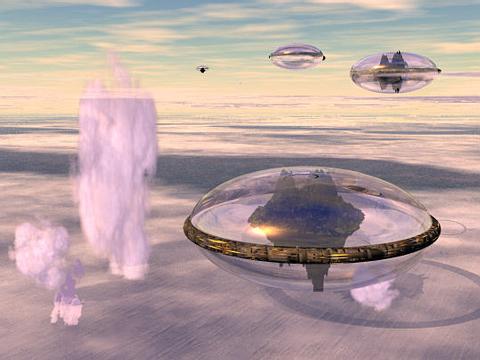 Image from Todd Drashner | |
| The Cloud Cities on Cumulous are supported by vacuum balloon tech | |
Composition
Of necessity bubblehabs are most often built of light low-weight materials. In part this is because a lighter lift envelope and supporting structure allow for a larger payload, and in part it is because heavier elements are often difficult to acquire in an atmosphere that typically consists primarily of hydrogen and helium with traces of some of the lighter elements. Foamed diamondoid, buckyfibre, and aerogel are key components in a bubble hab envelope, and many parts of the habitable spaces for bionts are often constructed of strong but lightweight plastics, or biological materials such as wood, or bamboo, or horn, either vat-grown or harvested from onboard life forms.The habs and the vast bulk of their contents are synthesized using elements refined from the atmosphere. Large quantities of air are taken in and useful portions separated from the rest. Even though hydrogen and helium are the primary components of gas giants, carbon, oxygen, nitrogen, sulphur, and phosphorous can be obtained in large quantities. Elements like chlorine and fluorine that easily form volatile compounds are there in small concentrations. Calcium, magnesium, iron, sodium, and silicon are much harder to obtain, though some are in the atmosphere in trace amounts as hydrides and can be obtained with prodigious sifting. However more typically they must be imported or created. They might be obtained on the planet's moons or elsewhere in the system and dropped into the atmosphere, they might be 'mined' through upwellings from the planetary interior, or they may be created either by a nearby Deep Well Industrial Zone or by specialized floating fusion transmutors.
The full range of elements and trace elements to support Terragen life and a biosystem, and to support some key technologies and a thriving mechosystem to support bionts, cyborgs, vecs, and ais alike takes some effort to obtain, regardless of the method. Fortunately, with the right choice of technology the amounts are rather small. For instance, a population of some trillion humans can be supported with only a few million tons of iron; a trivial amount in the mining operations of even a minor inner-system planet. However if supplies are cut and off and the population of habs has reached saturation, and the environment has already been scavenged of every loose atom, then airpirate raids from hab to hab, or habs that cannibalize other habs, can happen, as did in fact occur in the Dark Ages that followed the end of the Golden Age in Solsys, and has happened since on more than one occasion when a planet is cut off from the outside and civil order breaks down.
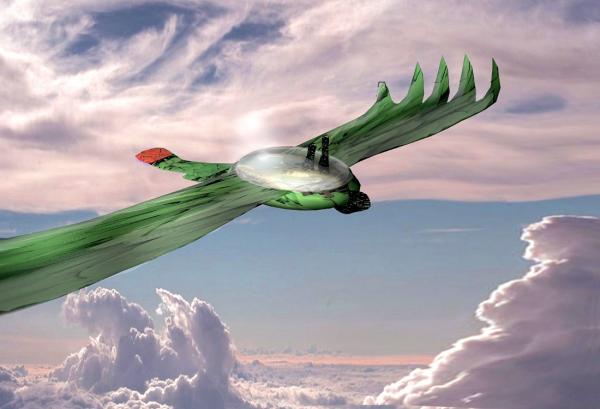 Image from Steve Bowers | |
| Macaw Bubblehab, a habitat capable of active flight and gliding on Canaria | |
Internal Environment
The first bubblehabs re-created conditions favourable to human baselines. However within broad limits the internal environment of a bubblehab can provide almost any temperature, pressure, and mix of liquids and gases desired by the inhabitants. For instance the Jade Chime Singers have recently begun to build bubblehabs that support their peculiar chlorine-rich biochemistry. Likewise Terragen tweaks and neogens with non-standard requirements simply build their hab's internal environment to suit. Many vec clades require only the stable platform and the power sources that the bubble hab provides, and use whatever the local atmosphere might be, with perhaps some protection from the local weather; some extreme biont tweaks also use this arrangement. Some bubblehabs have a habspace that consists entirely of computronium and supports only AIs or virch dwellers.Though in principle the pressure of the internal hab needn't match that of the external environment or that of the lift envelope, in practice it usually does, since otherwise additional measures are required to prevent leakage of gases in or out of the hab area. Habs that provide high pressure environments are quite common. The To'ul'hs have colonized many of the deeper layers of gas giant atmospheres. Aquatic clades that are already pre-adapted to high pressures have likewise gone deep, even though extensive aquatic environments require a much more substantial lift envelope in proportion to the living area than do those made for clades that are terrestrial.
Bubblehab environments built for humans or for the many other standard Terragens may substitute helium for nitrogen in the atmospheric mix, in part because helium is typically so easy to acquire relative to nitrogen and in part because a heliox mix avoids some of the problems with nitrogen narcosis that occur at high pressures for typical Terragen bionts. The choice of lighter atmospheric gases has some interesting effects on sound propagation, since it puts the sounds into a higher register. Early in the history of bubblehabs this led to some unique versions of the original baseline human languages, such as for instance, the Mikimosu and Chippamunk branches of Anglic, descendants of which exist even today.
One major aspect of life in a bubblehab that cannot be tailored to the inhabitants is gravity. Those living on the surfaces inside the bubble experience the ambient gravity of the host planet. For instance, in the ancient bubble habs of Solsys, dwellers on Jupiter experienced 2.53 gravs. Though many modern human tweaks/nearbaseline clades such as the Anakim find those conditions comfortable, such conditions were unacceptable to the human baselines of the time; the first colonists on Jupiter were either vecs or gengineered human tweaks. On the other hand Saturn's habs were at 1.07 g, Uranus' at 0.886, and Neptune's at 1.14, all quite tolerable to baseline Terragen life. Bubble habs in superjovian or brown dwarf atmospheres may require inhabitants who can withstand accelerations of up to 100 G. In these extreme circumstances the inhabitants may be radically unlike their Terragen progenitors, unless they are very small (like Anttechians) or aquatic (like the cetacean provolve clades) and so are unaffected by these extremes. Over time there has been a rise in the number of clades uniquely adapted to the heavier-grav situations in the bubblehabs of superjovians.
Motility
Typically bubblehabs do not float passively within the atmosphere, but have some ability to move. However they are not typically capable of moving as quickly as the winds of their environment, which may be moving at hundreds or even thousands of kilometres per hour relative to the planet itself. For long-distance travel they must work with the planetary weather systems. Bubblehabs have a variety of means of maintaining their orientation against the jostling of storms; such systems are particularly important for those habs that feature open basins of water in their internal environment.Power Plant
The availability of an atmosphere full of suitable isotopes for a fusion plant (especially helium-3) was one of the original advantages of bubblehabs; abundant power in proximity to abundant, if somewhat dilute, building materials made for an attractive combination when helium-3 for fusion power plants was a valuable commodity. Even with the advent of conversion reactors many bubblehabs retained helium-3 based fusion power plants, since breeding monopoles for the creation of new power plants is itself a difficult and expensive operation, and was initially beyond the resources of a typical bubblehab. Some bubblehabs supplement their energy supplies with wind power, or if they float in the upper part of an atmosphere that gets strong insolation with solar power gathered on the top of their lift envelope, but these supplemental sources are only brought into play for aesthetic purposes, or as an extreme emergency backup.Intelligence
Even the earliest bubblehabs were complex self-regulating 'organisms' as sophisticated in their subsystems as a biont plant, though they were steered and governed by their inhabitants. Sentient-grade but subturing systems soon followed, and not much later, before the close of the Golden Age, fully turing sapient-trade AIs became commonplace, although then as now many users found a sentient-grade habmind to be more than sufficient. In the current age a sophont hab-mind is quite unremarkable, and in fact some bubblehabs, particularly the larger individuals, are S1 or S2 transapients. Sapient or transapient bubblehabs that are neumann-capable, or that are manufactured on a standard template by other clades, constitute an entire class of sapient or even transapient clade themselves. Higher level transapients, S3 or greater, have been known to include bubblehabs as distributed aspects of their minds as well. Such subminds may be experienced by the inhabitants as sentient to transapient level beings who have strong connections to an archailect.Reproduction
Depending on the variety bubblehabs may reproduce by fission, by release of miniature larval forms that grow into full sized habs, or through seed-tech or spore-tech. In a suitable environment this feature allows colonists to produce many millions of square kilometres habitable space from a single original bubble hab within a very few years, though supplements of the rarer elements may be required if the gas giant's atmosphere is poor in those or lacks them entirely. Such reproduction must be carefully monitored by the future inhabitants if the bubblehabs are not themselves dedicated and self-aware Keepers. In a few cases subsentient to sentient bubblehabs left to their own devices for the necessary number of centuries have replicated and evolved and gone on to found entire botworld ecologies, even in the brief span of Terragen history. Some xenologists have speculated that such beings as the Jacks and their associated life forms may be the distant descendants of xenosophont-designed bubblehabs.Transportation & Communication
Bubblehab inhabitants use many of the same technologies as other planet-dwellers for communication and transportation. There are some significant differences, though. The sheer scale of their environment, the shifting relative location of the bubblehabs, the fact that all comm links must be wireless and all travel must be through a sometimes turbulent atmosphere, and the difficulties of leaving the extremely deep gravity well of a typical gas giant for travel off-planet all have strong effects.Communication between bubblehabs presents some special challenges. Unlike orbital communities bubblehabs rarely have unobstructed line-of-sight access to one another, and unlike other planetary or megahab communities they cannot rely on permanent hard links with broad-band capacity. Everything must travel through an atmosphere that is often cloudy and full of electrical storms, around the curve of a planet, and between stations that may be shifting relative to one another. A combination of laser, microwave, and radio stations, with heavy reliance on orbital comsats or floating repeater stations is typical. Lasers or masers are used for secure shorter range communication, and radio for longer distances. Bandwidth is a very significant issue. The overall effect is that the local implementation of the Known Net is slower and its nodes necessarily have greater independence and autonomy than in non-bubblehab networks. Bubblehabs in colonial areas without extensive planetary infrastructure may be extremely isolated. Where the local social order breaks down, as happened first during the post-Technocalypse Dark Ages of Solsys, a hab might not have 'outside calls' for months, years, or decades at a time.
Travel through the atmosphere between habs often depends on airships if speed is not an issue and if the cargo is bulky. For passengers this may not be satisfactory given the low density of habs and the very large distances between points in the atmosphere of a typical gas giant, so persons usually rely on heavier-than-air craft such as jets or turboprops. Even so, travel to a distant hab may require a significant investment of time. Even the most powerful aircraft experience limitations imposed by the resistance of the medium they travel through and by the weather systems they must traverse.
Travel off-planet is much more difficult for bubble hab dwellers than is space travel for those who live on orbital habs or for who dwell on typical icy or rocky planets and moons. Even with abundantly powered conversion or fusion rockets it takes some time to climb out of the local gravity well without crushing the passengers; the escape velocity for a gas giant is quite large. To get around this the highly developed communities tend to build orbital rings or mass streams and drop down skyhooks from that structure. In earlier times or in the colonies today bubblehab communities may take the less intensive approach of creating a maglev track that is supported by flotation devices in the atmosphere. Once low orbit is achieved, passengers and onboard equipment must also be shielded against the strong radiation belts that typically surround a gas giant.
Given the barriers to direct physical travel, some bubblehab cultures are given to making extensive use of engenerator or rental body tech for direct physical interactions, or content themselves with virch or eidolon 'bodies', or use scions rather than travel in person. Sending a scion still involves the same time delays, and the other methods are affected by the communication bottlenecks that go with bubblehab life, but in all cases use of such technology serves to ameliorate the relative isolation of bubblehab life.
Life in a Bubblehab
The View
Not every hab is designed to show the outside world, but many do either by displaying the entire outside sky on the ceiling of the hab or through windows. What may be seen varies considerably according to the kind of planet the hab is on. For instance, on a cryojovian like Jupiter or Saturn a hab at the 1 bar level is in the middle of the ammonia cloud layer and the view is of the clouds and whatever colours they may have by way of contaminants. On a clear day, or for a hab floating up at less than 0.7 bars, there is a thin haze of hydrocarbons overhead. The cloud decks beneath the hab may display some of the planet's famous colours, depending on the location. On a cold subjovian planet like Uranus or Neptune, the 1 bar level is above even the methane clouds, with perhaps a few thin layers of haze above in the stratosphere. The aquamarine or azure deeps below are very visible. In all cases the basic sky colour above is usually blue, just as on Old Earth. Other gas giants offer other sorts of views, from clear blue emptiness to fantastic cloudscapes to thick bland fog.The natural sunlight on the cool gas giants best suited to bubblehabs is relatively dim, though bright enough that a standard human baseline can see perfectly well. To take the example of Solsys once again, if the inhabitants use only natural light then at Jupiter the light on a clear day is brighter than it is on an overcast day on Old Earth and Saturn offers light brighter than in a typical human baseline's operating theatre, while light on Uranus is as bright as in an office or workshop and in Neptune it is comparable to that in a typical human's living room. Those are noonday levels, though, under a clear sky. Under clouds or at dusk, especially in the deeper layers of the atmosphere, the light levels are often unacceptably low. For these reasons, and because in some habs decorative or food crops are grown, supplemental lighting is common either over the entire hab or in certain key parts of it. It is not uncommon for a hab to have a high ceiling overhead. This may project a view of the outside world atmosphere, enhanced or otherwise, or if might show a simulation of the sky on a terrestrial planet or of an O'Neill habscape (the earliest bubblehab dwellers often made this choice) or it may have something else entirely, ranging from a utilitarian even light source to some artist's design.
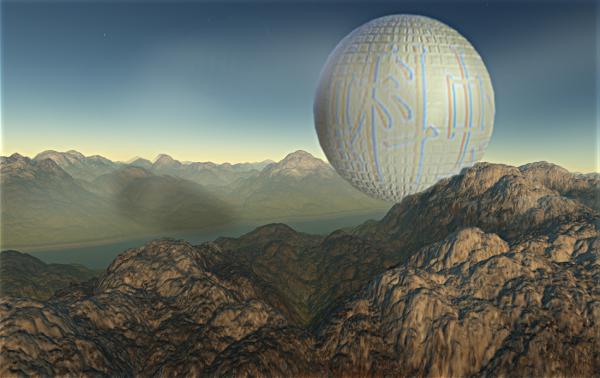 Image from Steve Bowers | |
| A fullair on Haixing - bearing an advertisment for a local soft drink, Kenla-Kedou | |
The Habscape
Basics such as temperature, pressure and chemistry aside the interior of the hab space may be almost anything. A common early design, still popular today, with human baselines, is a surface consisting of sylvan, parkland, or agrarian lands with a few scattered dwellings, with the hab's factories, machinery and commercial districts tucked 'below-ground'. Early hab dwellers often built this way in reaction to the crowded orbital habs and arcologies they had left behind. On the other hand some colonists chose to replicate their original habitat, with pleasant cityscapes. Today, a bubblehab's interior might hold almost anything, depending on the clade and culture of the inhabitants. Like other small habs, bubblehabs tend more strongly towards Clade Patternist principles, and may be adapted to a relatively narrow range, but many, especially the larger bubblehabs, use Universal Design principles. Such habs may make extensive use of utility fog to provide comfortable circumstances for a wide variety of tastes.Society
With the great diversity of clades in the modern age it is impossible to speak of bubblehab societies in any but the broadest of terms, but there are some tendencies. Physically, the individual habs seem to work best at anything from the size of a small household to a small city in terms of population, and even on a densely populated gas giant with a population in the trillions the actual physical distance between settlements is likely to be quite large. This makes the bubblehabs like islands in the in a large ocean relative to one another, though telecommunications and physical travel mitigate that somewhat. What is more, the positions of these populations relative to one another are changeable. While on the one hand habs can make a point of staying near one another and/or in close communication they may also quite successfully pursue a policy of isolation. This is aided by the self-sufficiency of bubblehab tech. Habs may sometimes be drawn together by a common need for resources, particularly projects to bring in materials from offplanet or from the depths, but in general each bubble hab can supply its own needs unless it is very small (minor habs associated with some larger hab are sometimes called a skerry). The net result of these factors tips things towards a degree of isolation and the political and cultural diversity that follows from it. Nation-states or empires are rare, but city states, freeholds of one or a dozen families, small clans and tribes, and the like are common. This kind of fragmentation and isolation gives huge scope for new cultures, philosophies, religions, languages, and so on to develop. A single planet may have trillions of inhabitants but show even richer and greater diversity than that seen on Old Earth before the increase in travel and communication during the Industrial Age began to level differences. This is not inevitable, of course: a common origin and language, and a habit of constant communication between habs may lead to a monoculture. But the tendency is towards diversity. A sociologist or sophontologist might spend thousands of years comparing and contrasting the cultures of just one gas giant.The bubblehabs are very easy to create. The technologies required are extremely primitive and ancient: the sort of things any small society of ordinary sapient beings might invent from scratch. In practice, of course, a group will look up bubblehab designs on the Known Net, or, even easier acquire a couple of hab seeds, and drop them in the local gas giant's atmosphere, rather than reinvent them. While the creation of a Bishop Ring or some other large hab might require much more infrastructure and a higher level of social cooperation, and the really big projects like Banks Orbitals need transapient levels of technology and coordination, and even the smaller space-based habs may need system-wide coordination to provide all the necessary elements, bubblehabs can be created quickly by small groups. Early pioneers, especially those who lack wealth or value simplicity, tend to favour their use. While the vast majority of bubble hab dwellers are sophisticated Inner Sphere zars, whose cultures reached their peak or plateau millennia ago, there are large and growing numbers of new bubblehab societies out on the Terragen Periphery.
The very large surface area and atmospheric volume of a jovian or subjovian planet can lead to huge populations on a well settled gas giant. If each 10,000 square kilometres supports a single 10 kilometre radius disk of hab dwellers, or perhaps more probably some rafts of smaller habs that add up to the same area, and if the inhabitants live at a population density on the disks inside those bubbles of a thousand people per square kilometre (for humans that means plenty of open space, not a completely "urban" environment) then population of a planet like Jupiter on that measure can be 2 trillion (tweaks/nearbaselines if humans), that of one the size of Saturn 1.3 trillion (baselines or nearbaselines), that of an ice giant like Uranus or Neptune about 250 billion. If the inhabitants want more elbow room each then those numbers might be an order of magnitude lower, and if they are happy to live at the kind of density a typical 1st century AT city (still one with plenty of parks and playing fields) those numbers may be an order of magnitude higher, or even two orders of magnitude higher. Even higher densities yet are possible, of course. Some clades actually prefer such crowding; the Eudorae are a good example. These are very minimal numbers, since in fact a gas giant typically supports not merely one layer of bubble habs but several, at levels both above and well below the 1 bar level.
In some cases the population supported by bubblehabs does not consist of ordinary sophonts. It is not uncommon for a transapient to use a bubblehab as its 'body'. S1s and S2s may use a bubblehab apiece. In this way a single gas giant may support a community of lower level transapients. There is a notable tendency for such communities to be or become isolationist ahumans, though that is hardly inevitable; in some cases there is a rich interchange between the transapients and lesser life forms such as sophonts. Higher level transapients, even mere S3s, are far too massive to be supported even by a Jovian planet with layer upon layer of bubble habs, but it is not unheard of for them to use bubble habs as part of a distributed mind with its main nodes either elsewhere, either in orbit or in the gas giant's deeps.
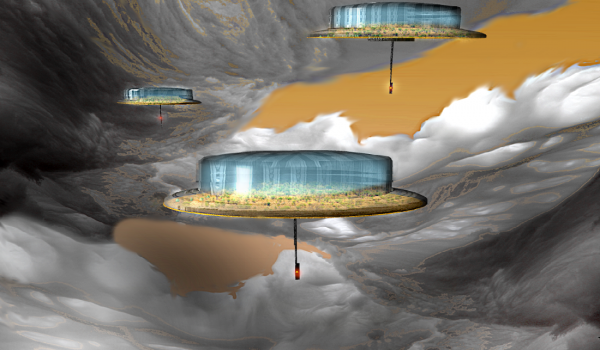 Image from Steve Bowers | |
| Hyena Bubblehabs in the atmosphere of Skulk | |
History
The technologies for basic bubblehabs existed quite early on. The first bubblehabs built for long term habitation, as opposed to temporary research stations, were constructed by the beginning of the 3rd century AT, and from a small beginning construction accelerated by the 230's. Given the extreme difficulties of life on Jupiter for baseline humans Saturn was the first region to see significant development. There were also some scattered colonies in the atmospheres of Uranus and Neptune; though their atmospheres were more favourable to the construction and flotation of bubblehabs and their ambient gravitational fields quite favourable to human habitation, they were more difficult to reach than Saturn, and further from the economic powerhouses of Old Earth, Mars, and Jupiter. Later, some heavy-gravity tweak/nearbaseline clades of humans made themselves at home in the atmosphere of Jupiter, though they were outnumbered by specialized vec, ai and upload communities that had preceded them. The Jovian settlements of all kinds tended to be closely aligned with the Jovian League and strongly influenced by Genetekker culture, while the allegiances of the bubblehabs on other planets were more diverse.These early settlements, though they were to grow more significant populations over the course of the next century or three, did not have a great deal of influence on the rest of Solsys. There was little or no emigration, due to the difficulties of leaving a gas giant's gravity well, and exports other than helium-3 consisted entirely of ideas rather than of materials, while the few imports consisted of small amounts of the heavier elements that are difficult to distill from the atmosphere of a gas giant. The immigrants took to calling themselves the Inworlders, or Floaters, and referred to everyone else, including a resident on another gas giant an Outworlder. Initially the hab dwellers were small groups of long-term researchers, or minders for the helium-3 extraction industry, but when bubblehab designs became sufficiently robust and widespread various dissidents, rebels, cultists, idealists, and so on would found these isolated regions quite attractive; many who sought to try a new way of life or to preserve an old one set out for one of the outer planets. Emigration to the gas giants accelerated two hundred years later in the 430's in the general expansion of emigration from Old Earth during that period. Backyarders who reached for the stars are better remembered in later history, but those content with the targets within Solsys, especially the gas giants and the rich supply of energy and materials there, were orders of magnitude more common and had a much higher success rate after they set out. A high rate of immigration, and a high rate or reproduction among the arrivals (some had left the Inner System specifically to escape the strict population control laws) caused the number of bubblehabs of all sizes to grow exponentially. By the close of the Golden Age demographers were predicting that the combined population of the bubble hab dwellers would overtake that of the rest of the system within three centuries. Many Inworlders confidently predicted that the future of Solsys would belong to the Floaters. However, this potential was not to be realized; the Technocalypse intervened.
The impact of the Technocalypse on the young bubblehab cultures and polities was even more devastating than that on Old Earth. Diseases like the infamous Satanic Imp virus infected habminds, and the atmospheres of the gas giants themselves were seeded with various kinds of self replicating wartech, varying from hostile nanotech microbes to predatory flying "deathbirds". In a few cases viral software sabotage killed the inhabitants and converted entire bubblehabs into platforms for destruction. The surviving hab societies cut off communication with the outside world and with each other as well. Rogue or pirate habs increased; ideological rivals took the opportunity of the general chaos to settle scores, isolationists took extra pains to hide themselves and cut links to the outside world. For the bubblehab dwellers, Solsys' Dark Ages began early and hit hard. Then, beginning in 621, another outside reality crashed in on the survivors of the Technocalypse themselves: waves of refugees from Earth, many of them equipped with basic bubblehab seeds by GAIA's agents. The Treaty Org did not sponsor many expeditions to the gas giants, being content to establish cislunar orbitals and lunar colonies, so most of this new wave consisted of GAIA supporters, independents, or Backyarders. Some of these newcomers were content to carve out territories of their own but others, once they have their bearings, began to make war on each other or on the native Inworlders descended from earlier waves of colonists.
Another and larger wave of war and destruction was to follow the refugees, one that destroyed any hope of an immediate recovery. In 685, all but the most vigilant and fortunate bubblehabs in Jupiter's atmosphere were destroyed in the "Great Shedding"; the very few and very paranoid survivors took up an attitude of war towards everyone, Outworlders and Inworlders alike. The infection spread. Saturn and the other gas giants were less strongly affected, but in many of the surviving habs conditions were grim: poverty, tyranny, and ignorance prevailed, with the exception of a very few and very well defended and hidden habs that had been more fortunate in their history. On Saturn these included Valinor, the Hidden Realm, where a proud clade of human nearbaselines lived in freedom and prosperity in a sylvan setting with a high tech underpinning, and Laputa, where a clade of cyborged baselines established a rigid but effective meritocracy that managed to preserve most of Old Earth's technical and scientific knowledge. These and other great powers were threatened by the hordes of less favoured habs, and most particularly by a collection of habs that were ruled by despots and demagogues and lived in high tech savagery and were predators on any weaker community. The Sons of Kronos, known as The Eaters for their habit of assimilating and subjugating all other societies (and, it is said, for their occasional personal cannibalism), were perhaps the most famous of these. This deepest Dark Age did gradually begin to improve, though slowly. Some of the more advanced habs began to extend their influence, forming protectorates. Some of the best remembered of these are the Han Hegemony and the Warriors of the Western Stream. Uranus and Neptune followed similar histories, with different players.
In the middle 700's EOCC missionaries and emissaries from the orbital habs began to appear on Saturn. Their influence was limited at first, and there were a number of notable martyrdoms, but their memetic influence led to a reduction in warfare and oppression, though not without the side effect of turbulent politics and occasional bloody revolutions within habs. Over the following two hundred years the war and distrust between Saturn's bubblehabs, and the savagery and oppression within the worst of them, began to ease. Similar improvements were seen at Neptune, Uranus, and even Jupiter. Nevertheless, the populations of the gas giants were late joiners to the Federation, and there were holdouts even in the mid 1000's. By that time, the Inworlders had deep cultural tradition that included limiting their populations (in strong contrast to the inclinations of their distant ancestors) and preserving broad vistas of empty air around their settlements. The terms under which they joined the Federation included provisions that prevented large scale immigration to their habs, or the creation of large numbers of new bubblehabs. Though potentially the gas giants might have been the population centres of Solsys and though they remained politically powerful from Federation times through to the current Solsys Organization they never became the massive influence that they might have if they had allowed their populations to grow to their maximum size.
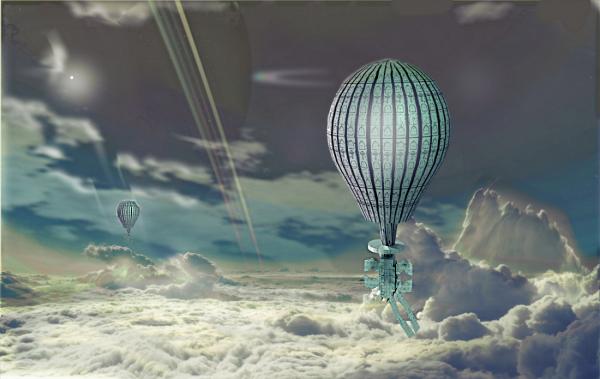 Image from Steve Bowers | |
| The vecs of Arugula inhabit hot hydrogen balloon cities, where they refine helium3 for export | |
Elsewhere other star systems with other histories did see a more significant role for the gas giant populations. This was particularly true in systems that had suitable gas giants but were short of terrestrial planets or asteroid belts. Skyholm (47 Ursae Majoris c), Didi (Mu Arae e), Herakleus (HD 154345 b), and Veedu (55 Cancri f), are just a few of the most notable from early Federation Age history.
In the current day although the vast majority of bubblehabs are in the Inner and Middle spheres, bubblehabs are a signature technology for colonists along the Periphery. There are occasionally serious disagreements between the bubblehab dwellers, who tend to have arrived first in a system, and others who favour sunlines, stellification projects, deep well industrial zones, or other extensive modifications of a gas giant that are not compatible with the first colonists' lifestyles. These disagreements are not always solely for practical reasons. For instance, an equatorial sunline need not prevent extensive bubblehab development. However as it has for so much of Terragen history ideology often trumps practicalities. Out on the Periphery, away from the influence of the rest of the Civilized Galaxy, such disputes may degenerate into war or even genocide.
A trend over Terragen history has been an increasing number of clades and individuals adapted specifically to hab space on particular kinds of gas giant. Specialists in the extreme heavy-gravity and high pressures found in the deeps of superjovians are quite common, though they seldom visit the rest of the Terragen Sphere in person. Likewise there are clades of Floaters who are Keeper minds of bubblehabs themselves and do not leave their birth planet unless they also leave their bodies.
Many Hiders live in bubblehabs, especially in the Stevensonian class 'rogue' gas giant planets between the stars. The energy signature of such civilizations is nearly impossible to pick out, even when such planets are located, against the background emissions of the planet itself. As with so much else about the Hiders it is difficult to know how many and how widespread they may be, but some believe that the number of such hidden bubblehabs is enormous.
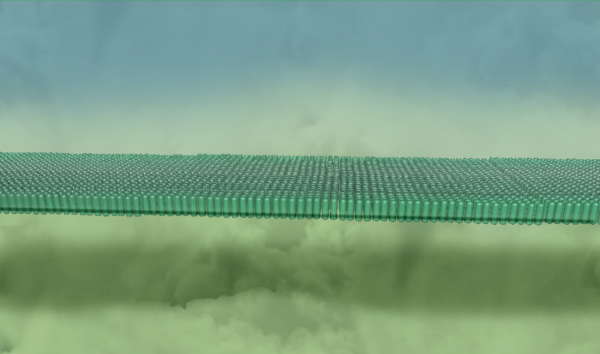 Image from Steve Bowers | |
| The Equatorial Tape on Blanchard is a continuous strip of bubblehabs that girdles the entire planet | |
Timeline
220 AT - First bubblehabs at Saturn. Initially these are scientific stations, but soon they are upgraded to small settlements that supervise helium-3 extraction and export operations.230 AT - Bubblehabs on Venus are built on a small scale.
240 AT - Colonists from the Jovian League establish high-grav tweak colonies in bubblehabs on Jupiter.
260 AT - Bubblehabs established at Uranus.
290 AT - Bubblehabs established in the atmosphere of Neptune.
300 AT - Bubblehabs established at Venus are nearly fully self-sufficient.
370 AT - Widespread emigration to newly created bubblehabs in the atmospheres of all planets with bubblehabs; Saturn is the recipient of the majority of human baseline immigration; Jupiter remains the domains of tweaks and vecs.
380 AT - The many new stable designs for artificial biospheres make bubblehabs nearly independent for most materials and energy, but there is a brisk trade between bubblehab communities and the sources of the few critical heavy elements. Earth, Luna, Mars, and the various Belt polities trade these for the abundant supplies of helium-3 that the bubblehab settlements ship offplanet.
410 AT - Autonomous bubblehabs, not specifically aligned with an external founding nation, religious organization, or transnational, begin to predominate, particularly in the atmospheres of Saturn, Uranus, and Neptune; a division between 'Inworlders' and 'Outworlders' begins to develop. At the same time, with the rise of the Backyarders and especially the Neotribalist Backyarders, many new immigrant/refugee groups arrive from the high-surveillance polities of Old Earth and other insystem regions of Solsys. The first primitive self-replicating bubblehabs are developed, though most new habs are still simply constructed by their future inhabitants.
432 AT - Fullairs, bubblehabs built for Old Earth conditions, are available as a nanofab template within the Backyarder culture.
450 AT - Massive growth in populations and economic power of the bubblehabs in Solsys. Native bubblehab polities rise to prominence, an event known to Inworlders, especially those on Saturn, as 'The Blooming'. Outworlder news organizations begin to refer to the 'Floater' or 'Inworlder' polities and metapolities as 'the new giants of the system'.
565 AT - The chaos of the Technocalypse reaches the bubblehabs everywhere in the system, as various and sometimes unidentified factions target helium-3 production facilities. Massive loss of life, in some cases in excess of 50% of the native populations. Subsequent wars between surviving Inworlder groups, and wars of retribution against Outworlder aggressors (real and imagined) cripple trade and communication. A disproportionate number of the survivors are in pre-existing Hider bubble-habs, or in communities that adopted a Hider strategy early in the conflict. They employ stealth technologies and move to below the traditional one-bar pressure level. These 'Dropouts' will be a powerful influence on future developments.
621-640 AT - The Great Expulsion leads to massive emigration of Earth refugees into newly constructed bubblehabs in the atmospheres of Saturn, Uranus, and Neptune. Venus is bypassed as too dangerous due to its remaining mechosystem, and Jupiter as too hostile to humans and other Earth-adapted clades not only because of its high gravity but because of aggressive native clades, survivors of the original Genetekker colonies. Saturn absorbs the majority of refugees, just as before the Technocalypse it was the target of choice for less desperate immigrants. Some refugees to these regions are gifted by GAIA with self-maintaining and self-replicating seedtech bubblehabs. After a period of cautious observation the designs for these are bought or stolen and are widely copied and adapted by the existing populations as well.
685 AT - The Great Shedding destroys most of the bubblehabs in Jupiter's atmosphere. The very few and very paranoid survivors, mostly vecs and Genetekker-derived tweaks descend into technosavagery. Hostile sporetech devices, some specifically designed to destroy bubble habs (deathbirds, bubblemites), reach the atmospheres of the other gas giants, causing great loss of life. Isolationism is the primary survival strategy.
700's AT - Bubblehabs at Venus are destroyed or depopulated as the last few survivors fall to the atmosphere's hostile neumanns. In the Outer system, growth of further bubblehabs is limited by the need for heavier elements. These may be obtained through time-consuming sifting of the atmosphere, through the tiny trickle of interplanetary trade, or by taking them from other bubblehabs. In the atmospheres of Solsys' gas giants this is the era of the infamous Sky Pirates and Cannibal Cities.
800's AT - The bubblehabs of Uranus and Neptune begin to emerge from the Dark Age, with the growth of beneficial trade and communication within and beyond the atmosphere, as the bubblehabs develop new connections with each other and with the local orbital and lunar settlements. Around Saturn the situation is more complex; the Han Hegemony and the Warriors of the Western Stream bring a degree of peace and harmony to the habs that fall under their sway, but the 'objective/utilitarian' Children of Kronos (known to their detractors as 'The Eaters') bring about their own brutal definition of order to the habs they subjugate. EOCC emissaries and missionaries from the orbital habs attempt memetic manipulations that sometimes ameliorate the repression and warfare of the era, though at times the transition to gentler societies itself causes great loss of life. In the background, the famous Hidden Cities of Dropouts such as Laputa and Valinor attempt to preserve their security and influence. Jupiter's few bubble habs are in a state of anarchy and war, struggling against each other and against ongoing predatory activity by hostile self-replicating devices.
900's AT - The bubblehab dwellers in Solsys are gradually integrated into the Federation. There are some early enthusiastic joiners on Saturn, but many holdouts. Polities based on Uranus and Neptune are late to join, having already established a high degree of peace and prosperity on their own. Jupiter's technosavages are only gradually coaxed into membership after centuries of persistent missionary activity, long after the atmosphere of Jupiter itself is cleansed of its free-breeding population of hostile nanotech devices by Federation 'blue-goo' sporetech.
1000 - 1500 AT - Bubblehab tech, based on variants of the original designs by GAIA, is widely used. Within Solsys itself the old Inworlder powers generally opt for a very low population density and have strong but limited influence on local affairs. Elsewhere, bubblehabs lead to massive population growth, and together with the economic influence of their helium-3 exports this can mean that Floater societies based on bubblehabs are predominant in a system's culture and politics. The only check on their relative power is the difficulty of corporeal travel from within the deep gravity wells of the gas giants to the rest of the local system.
1485 AT - Conversion reactors employing the monopoles provided by transapients become widely available and are routinely constructed by ordinary sophonts; the relative importance of helium-3 refining declines, as does the relative energy advantage of habs located directly within a source of this critical material; by the middle of the 16th century polities based on bubblehabs are less prominent than they had been in the affairs of a typical star system.
1550 AT onwards: Bubblehabs of one sort or another are a standard kind of Terragen habitat. Conversion drives and megascale projects that create transportation links greatly reduce the old Inworlder/Outworlder divide, though in the case of colonies on superjovians and cool brown dwarfs bubblehab dwellers may be strongly localized, and only travel, if at all, to comparable environments. Clades specifically adapted to bubblehabs are common. There are a number of sophont clades that are themselves bubblehabs, accustomed to hosting populations of sentient and sophont riders. 'Seeding' a new gas giant with self-replicating bubblehabs is a common strategy for colonists in new systems.
2640 AT - Discovery of the first extensive botworld descended from bubblehabs; the founding population was a sentient-grade neumann-capable model that had been sent to what was then the Periphery by early Federation Age colonists who chose another target and did not arrive. Many other botworlds have arisen since as a result of unsupervised bubblehab reproduction. Some can be 'tamed' and others cannot. This has led to some strict laws regarding bubblehab design and supervision in most parts of the Civilized Galaxy.
7120 AT - Evolutionary biologists and paleoxenologists associated with the HIE and the Ozymandias Institute announce evidence for the hypothesis that the Jovic life forms associated with the Jacks are distant descendants of xenosophont-designed bubblehabs.
Bubblehab Argot
Blooming, The: the first rush of bubblehab creation and colonization in Solsys; also any similar early high growth phase in Terragen colonization efforts.Bubblemites: small synsects that infest the exterior of a bubblehab; the original military versions were designed to destroy the lift envelope, but some evolved versions are simply low-grade parasites. The term is not usually used for maintenance synsects that operate on the same scale.
Deathbird: any hostile neuman-capable device; usually but not always a heavier-than air object; deathbirds commonly had an aerostat 'nest' that served as a centre of reproduction and in some cases the deathbird nest was a former bubblehab.
Dropout: Hiders; cultures or individuals who try to conceal their settlements, often by living in the deeper cloud banks of the atmosphere.
Floater: any dweller on a bubblehab.
Inworlder: a resident of a bubblehab on the same planet.
Outworlder: anyone who lives off-planet, including Floaters from other planets.
Skerry: a set of smaller peripheral bubblehabs that float together with a larger hab and are in a dependent or symbiotic socioeconomic relationship with their parent hab.
Take the Plunge: an early Inworlder term for immigrating to a gas giant; for middletech Terragens this was typically a one-way trip due to the time and expense of leaving the gravity well once more.
Technosavage: not exclusively a Floater term. Technosavages use high technologies but do not have any deep understanding of their technology, or derive new technologies. The term has connotations of primitive social organization and a hostile militaristic ethos.
Artificial planetary surfaces
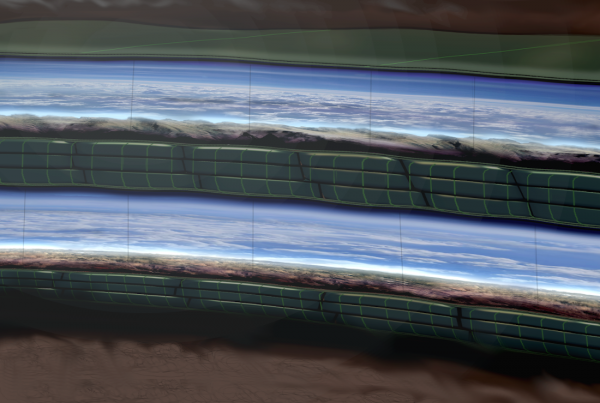 Image from Steve Bowers | |
| The neptunian planet Purcell has two concentric layers of continuous habitable surface supported by gas pressure. Since the layers are in tension, separation between the layers can be controlled by strong vertical tethers | |
Further improvement is possible once an artificial surface is constructed. The overlying atmosphere can be converted into a breathable one by removing the excess hydrogen and helium (by exporting it off-planet and/or pumping it down to beneath the artificial surface), and making other changes as needed. This can allow gas giant planets to be partially terraformed (depending on one's definition of the term). It is also possible to create multiple artificial surfaces, resulting in a shellworld. An example of such a gas-supported shellworld is the neptune-like planet Purcell.
During construction of an artificial surface, all or most of the bubblehabs will need to be able to function as weather machines to control the wind and prevent it from disrupting construction. Even then, some planets are simply too windy or turbulkent for the creation of an artificial surface.
Further Reading
Aloysius Garamalalage, Castles in the Air: Bubblehabs from the Interplanetary Age to the Present.Jongmin Hasanovich, The Tribes of Jupiter: Technosavages and Bubblehab Isolationism.
Adam Zheng, Lighter than Air at a Hundred Gravs.
Halima Anderson, The Sky Pirates of Saturn.
Jupraj Cacchione, Floaters in the Wreckage of the Apocalypse: Bubble Habs in the Dark Ages of Solsys.
Delta Ion Magellan and Iota Ion Magellan, Bubblehabs of the Hiders.
Jadeite Manyhands, The Design and Breeding of Subsapient Bubblehabs.
Related Articles
- Arugula
- Atmosphere - Text by M. Alan Kazlev
The gaseous envelope surrounding a planetary object, moon or star, (or possibly the habitable surfaces of an artificial structure. A typical atmosphere consists of a mixture of gases. Some of the most common are hydrogen, helium, methane, nitrogen, oxygen, argon, carbon dioxide, water vapour, and ammonia. Often an atmosphere is divided into zones of similar pressure, temperature, and composition. - Blanchard
- Bone-Claw (Eta Cephei)
- Cumulous
- Dirigible
- Dome Habitats
- Eganfodugbe
- Four Seasons Habitats
- Fullairs
- Gas Giant
- Greenbubbles (Space Canopies)
- Hab / Habitat
- Habitat (biology) - Text by M. Alan Kazlev
Any space (which includes food, water and shelter) suitable for the survival and reproduction of an organism. - Jovian Class
- Vacuum Dirigibles
- Venus
Appears in Topics
| 400 to 530 AT: The Solsys Golden Age | 530 to 900 AT: The Sundering | Atmospheric Transport |
| Construction | Infrastructure | Megascale Engineering |
| Middle Tech / Midtech |
Development Notes
Text by Stephen Inniss, With additional material by Tardigrada 2021
(other additions and suggestions by Steve Bowers, Luke Campbell, Todd Drashner, Craig Higgs, Mike Miller, & Mark Ryherd) Snapshot by Addemup
Initially published on 19 January 2012.
(other additions and suggestions by Steve Bowers, Luke Campbell, Todd Drashner, Craig Higgs, Mike Miller, & Mark Ryherd) Snapshot by Addemup
Initially published on 19 January 2012.
Additional Information
Fiction about Bubblehabs
A story by Stephen Inniss about the aftereffects of the Technocalyspe on the bubblehabs can be found in After Tranquility, the second Orion's Arm anthology
------------------
Image 'Bubblehabs' copyright by Lilly Harper used with permission. Please contact her for conditions of re-use at https://beaconsinthedark.wordpress.com/.
A story by Stephen Inniss about the aftereffects of the Technocalyspe on the bubblehabs can be found in After Tranquility, the second Orion's Arm anthology
------------------
Image 'Bubblehabs' copyright by Lilly Harper used with permission. Please contact her for conditions of re-use at https://beaconsinthedark.wordpress.com/.






